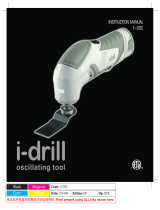
5
en
Special safety instructions.
Hold the power tool by the insulated gripping
surface when performing operations where
the application tool could contact hidden
wires. Contact with a “live” wire will also
make exposed metal parts of the power tool
“live” and shock the operator.
Use clamps or another practical method to
secure and support the work piece on a stable
surface. When holding the work piece only
by hand or against your body, it remains in an
unstable position, which can lead to loss of
control.
Do not use accessories which are not specifi-
cally designed and recommended by the
power tool manufacturer. Safe operation is
not ensured merely because an accessory fits
your power tool.
Grasp/hold the power tool in such a safe man-
ner that your body never comes in contact
with the application tool, particularly when
working with application tools pointing
toward the gripping area, such as with saw
blades or cutting tools. Touching sharp cut-
ting edges or edges can lead to injury.
Wear personal protective equipment. Depend-
ing on application, use face shield, safety
goggles or safety glasses. Where appropriate,
wear dust mask, hearing protectors, gloves
and workshop apron capable of stopping
small abrasive or workpiece fragments. The
safety glasses must be capable of protecting
against flying particles generated by the vari-
ous operations. Prolonged exposure to high
intensity noise may cause loss of hearing.
Do not direct the power tool against yourself,
other persons or animals. Danger of injury
from sharp or hot application tools.
Do not rivet or screw any name-plates or
signs onto the power tool. If the insulation is
damaged, protection against an electric shock
will be ineffective. Adhesive labels are recom-
mended.
Clean the ventilation openings on the power
tool at regular intervals using non-metal
tools. The blower of the motor draws dust
into the housing. An excessive accumulation
of metallic dust can cause an electrical hazard.
Use and handling of the battery
(battery pack)
To avoid hazardous situations such as burns,
fire, explosion, skin injuries, and other inju-
ries when handling the battery, observe the
following instructions:
Batteries must not be disassembled, opened
or reduced in size. Do not subject batteries to
mechanical impact or shock. Hazardous
vapours and fluid can escape in case of dam-
age and improper use of the battery. The
vapours can irritate the respiratory system.
Liquid ejected from the battery may cause
skin irritations or burns.
When battery fluid from a damaged battery
has come into contact with objects close by,
check the respective components, clean them
or replace them as required.
Keep the battery away from heat and fire. Do
not store the battery in direct sunlight.
Do not remove the battery from its original
packaging until it is going to be used.
Before any work on the machine itself,
remove the battery from the power tool. If the
power tool accidentally starts, there is danger
of injury.
Remove the battery only when the power tool
is switched off.
Keep the battery away from children.
Keep the battery clean and protect it against
moisture and water. Clean contaminated bat-
tery terminals and power tool connections
with a dry, clean cloth.
Use only intact original FEIN batteries that are
intended for your power tool. When working
with and charging incorrect, damaged,
repaired or reconditioned batteries, imita-
tions or other brands, there is danger of fire
and/or explosion.
Follow the safety warnings in the operating
instructions of the battery charger.
OBJ_BUCH-0000000251-001.book Page 5 Monday, February 8, 2016 12:04 PM





















